|
Getting your Trinity Audio player ready...
|
Since launching seven years ago, Buro24/7’s publishing proposition has focused on connecting the world’s most desirable brands with the most sought-after demographic – the affluent millennial – or as I like to call them, the ‘re-inventors of luxury’.
Initially, to form legitimacy in what we could offer luxury brands, we focused on building our presence in emerging luxury markets such as Singapore, Malaysia, Australia and Croatia, after a successful launch in Russia. This allowed us to form long-lasting relationships with a number of luxury brands – many of whom were new to these markets – while also offering them access to a younger, digitally savvy and affluent audience. Indeed, many luxury brands are continually reinventing themselves to meet the demands of this consumer – be it with modernised brand identities, new designers that come with a feverish and youthful fan-base or by changing the in-store experience to be, well, an actual experience.
It’s hardly surprising that this audience is the bullseye target for many luxury brands; according to The Economist, millennials (those aged 18 to 34) will be the main consumers of luxury by 2026. Primarily, millennials view luxury as an experience, not just the aspiration of owning something exclusive; meaning the purchase of a luxury handbag is held in as high regard as a night out to a new expensive restaurant with friends. The commonality between the two is the ability to share the experience and gain social status amongst their network of friends. For this reason, Buro24/7 has held a broader editorial remit than traditional prestige publishing brands aimed at women – more legitimately covering art, culture, travel and lifestyle, in equal weight to beauty and fashion.
For us, it’s about inspiring a life of experience through editorial.
In many ways, appealing to this affluent millennial audience is also what informed Buro24/7’s rebrand and website redesign this month. With our new look and feel, we’ve reinterpreted the notion of 24/7 with our Buro dot design that symbolises a moving hand around a clock, the earth moving around the sun or even a single audience member moving around a much larger Buro community. Importantly, the brand has been designed for easier and clearer recognition by the affluent millennial audience on mobile where symbolism or ‘the emoji economy’ are better forms of communication – engagement is ruled by the speed of a roll of a thumb or swipe of a finger.

Being a digital native, we’re not held back by the legacy of print, and so we can readily increase output in any one of these editorial categories, given the nature or trend of the audience via data interpretation. We’ve also had a flexible editorial charter across the 11 countries in which we’ve operated, charging our editors to produce data-led content based on their audience. For example, in Australia, the rise of self-improvement luxury experiences peaked in traffic and audience engagement for Buro 24/7 and that became a key factor in its early success. Meanwhile, in Singapore, technology is seen as an extension of one’s own self, and so they have a comprehensive technology section focusing on premium tech-product, which has a nice bonus of also attracting a share of male affluent audience members.
Despite these early successes, we recognise that Buro24/7 is relatively unknown in Western Europe outside of luxury brands, so the upcoming launch of our flagship site in the UK in Q1 2019 will be a big test for us. Particularly as Western Europe has always been a difficult market to crack in terms of performance for luxury brands. The segmentation of the luxury consumer profile is so diverse that it’s difficult to market to any one consumer. That said, our experience with many of the cultures who make up the luxury consumer in the UK will certainly work to our advantage, and we also understand the importance of personalisation – both from a content and commercial standpoint – which will be another unique proposition we’ll invest in heavily.
But what makes this move so unique? Well, it goes without saying that most of the traditional publishers such as Condé Nast are focusing on extending to emerging luxury markets, rather than the other way around, as evidenced by the recent launch of GQ in the Middle East. So, while our strategy may be in reverse, we’ve built a vast knowledge of our ‘re-inventors of luxury’ across our network and already work with 20 of the top luxury brands, helping them to deliver interactive experiences through digital, social and offline activities that drive awareness, consideration or purpose.
Success in the world of luxury publishing is akin to how luxury operates in any other category; you have to have a globally-desirable brand that can resonate independently in any given market by knowing its local clientele inside and out. Having met our editorial leaders across the globe, it’s clear just how acutely aware they are of how their own culture infiltrates a luxury lifestyle. And so, in the UK, we’re embarking on attracting the very best editorial talent that can both personify the affluent millennial and deliver them the UK luxury experience; in turn offering advertisers the best means to engage this audience. Best of all, by being keenly focused on digital and being led by audience data, we can pivot much faster to where our audience and clients need us to be.
By Nick Smith, CEO, Buro Global
Photo by João Silas on Unsplash


